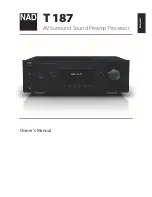
OPTIMOD-AM DIGITAL
OPERATION
3-9
programming the
L
ESS
-M
ORE
curves, we have made it easy for you to make this
trade-off. As you advance the
L
ESS
-M
ORE
control for a given factory preset, the sound
gets louder but distortion increases. However, for each setting of the
L
ESS
-M
ORE
control, other processing parameters are automatically adjusted to give you the lowest
possible distortion for the amount of loudness you are getting.
If you want to go beyond
L
ESS
-M
ORE
and into the
F
ULL
C
ONTROL
and
E
XPERT
M
ODIFY
adjustments, you should carefully read and understand the following section. It
provides the information you need to adjust OPTIMOD-AM controls to suit your
format, taste, and competitive situation.
Judging Loudness
Apparent loudness in an analog AM channel will vary with the frequency response of
the radio and with the accuracy with which the radio is tuned. Narrowband radios will
usually get very much louder if tuned off center while a highly equalized signal is
being received. Loudness is a very complex psychoacoustic phenomenon. One station
cannot be judged louder than another unless it is
consistently
louder on many
different receivers with many different types of program material. Because a
wideband radio reproduces more of the frequency range in which the
highly-equalized signal concentrates its energy (and to which the ear is most sensitive),
a highly equalized signal may sound quieter than an unequalized signal on a
narrowband radio, while the reverse is true on a wideband radio.
Reverberation
In the distant past, the addition of artificial reverberation was touted as an easy
method of achieving greater loudness in AM broadcasting. Given the limitations of the
audio processing equipment of that time, this was true: reverberation increased the
signal density and average modulation without the pumping or other side effects that
heavy limiting would cause if equivalent density were to be achieved by compression
or limiting alone. However, because reverberation “smeared” the sound, it exacted a
price of decreased definition and intelligibility in many instances.
Because OPTIMOD-AM is to augment density without producing audible artifacts,
reverberation is neither necessary nor desirable for achieving high loudness and
density. Moreover, OPTIMOD-AM actually increases definition and intelligibility.
If you still wish to use reverb to achieve a nostalgic sound in an oldies format, we
recommend using it in extreme moderation and applying it to the signal before it
reaches OPTIMOD-AM. OPTIMOD-AM will effectively increase the amount of reverb by
increasing the level of the reverb decay and keeping the reverb before OPTIMOD-AM
will allow OPTIMOD-AM to control peak modulation accurately.
Customizing the 9300’s Sound
The subjective setup controls on the 9300 give you the flexibility to customize your
station’s sound. Nevertheless, as with any audio processing system, proper adjust-
ment of these controls consists of balancing the trade-offs between loudness, den-
sity, and audible distortion. The following pages provide the information you need
to adjust the 9300 controls to suit your format, taste, and competitive situation.
Summary of Contents for OPTIMOD-AM 9300
Page 1: ...Operating Manual OPTIMOD AM 9300 Digital Audio Processor Version 2 0 Software...
Page 7: ...Operating Manual OPTIMOD AM 9300 Digital Audio Processor Version 2 0 Software...
Page 178: ...3 46 OPERATION ORBAN MODEL 9300...
Page 200: ......
Page 221: ...OPTIMOD AM DIGITAL TECHNICAL DATA 6 21...
Page 222: ...6 22 TECHNICAL DATA ORBAN MODEL 9300 CONTROL BOARD PARTS LOCATOR...
Page 228: ...6 28 TECHNICAL DATA ORBAN MODEL 9300...
Page 229: ...OPTIMOD AM DIGITAL TECHNICAL DATA 6 29 I O DSP BOARD LEFT AND RIGHT ANALOG INPUTS...
Page 230: ...6 30 TECHNICAL DATA ORBAN MODEL 9300 I O DSP BOARD ANALOG OUTPUTS...
Page 231: ...OPTIMOD AM DIGITAL TECHNICAL DATA 6 31...
Page 238: ...6 38 TECHNICAL DATA ORBAN MODEL 9300 FRONT VIEW REAR VIEW FRONT PANEL PARTS LOCATOR DIAGRAM...
















































